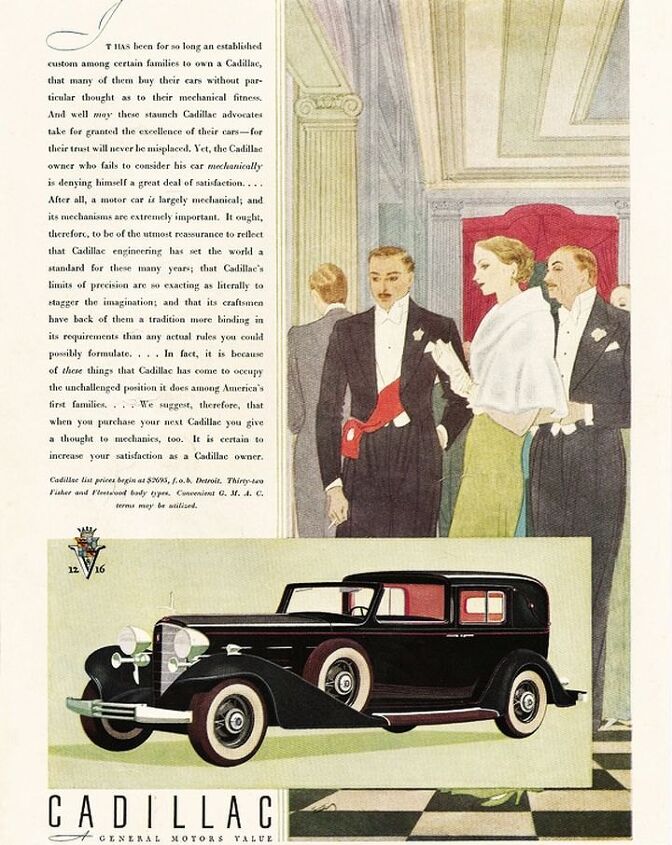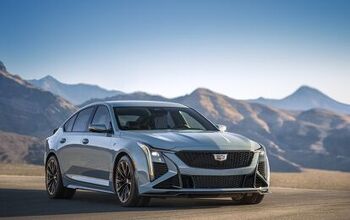Rare Rides: The 1933 Cadillac V-16 All-weather Phaeton

In the midst of the Great Depression, Cadillac offered a new range of ultra-expensive motorcars that featured 16-cylinder engines – a count never offered previously by a domestic automaker. One of the V-16’s most prestigious variations is today’s Rare Ride.
Presenting the extremely exclusive All-weather Phaeton sedan.
Customers could choose from among 10 different body styles, built by the coachbuilders in and around Detroit. Each firm assembled their bodies atop a wooden frame. Available body styles included five- and seven-passenger sedans and limousines, convertibles and coupes for two, larger coupes that carried five, as well as town car styles for five or seven, and large convertible sedans (phaetons). Pictured above is the Brougham, where your hired driver sat outside because they were poor. Customers consulted with their Cadillac dealer to personalize the V-16 in almost innumerable ways, adding their own personal sense of style inside and out.
The first run of V-16 cars was from 1930 to 1937, and Cadillac sold around 3,800 in total. For the 1933 year in particular, 126 cars were built. A second generation V-16 debuted for 1938 and merged Cadillac’s prior V-12 and V-16 engines into a singular offering in the newly-designed 7.1-liter V-16. As WWII heated up, production ended in December 1939 with less than 500 second-gen V-16s completed. It was the only time Cadillac made a production V-16 engine.
Today’s Rare Ride started out in life with a standard Fleetwood-built sedan body. Through a couple of owners, this car made its way from New Jersey to St. Louis in the Sixties. There, it had its sedan body swapped with an original All-weather Phaeton body from the same model year. It was then restored to the highest order and kept in pristine condition since. In beautiful navy over navy, the Cadillac sold recently for an undisclosed sum.
[Image: Cadillac]

Interested in lots of cars and their various historical contexts. Started writing articles for TTAC in late 2016, when my first posts were QOTDs. From there I started a few new series like Rare Rides, Buy/Drive/Burn, Abandoned History, and most recently Rare Rides Icons. Operating from a home base in Cincinnati, Ohio, a relative auto journalist dead zone. Many of my articles are prompted by something I'll see on social media that sparks my interest and causes me to research. Finding articles and information from the early days of the internet and beyond that covers the little details lost to time: trim packages, color and wheel choices, interior fabrics. Beyond those, I'm fascinated by automotive industry experiments, both failures and successes. Lately I've taken an interest in AI, and generating "what if" type images for car models long dead. Reincarnating a modern Toyota Paseo, Lincoln Mark IX, or Isuzu Trooper through a text prompt is fun. Fun to post them on Twitter too, and watch people overreact. To that end, the social media I use most is Twitter, @CoreyLewis86. I also contribute pieces for Forbes Wheels and Forbes Home.
More by Corey Lewis
Latest Car Reviews
Read moreLatest Product Reviews
Read moreRecent Comments
- SCE to AUX I am generally anti-union.To win over the workers, the UAW has to convince them that:[list][*]The court of public opinion (internet, social media, local/national news) is insufficient to air their gripes (it's not).[/*][*]The Company is in sustained violation of established workplace regulations for comfort, safety, and well-being (unlikely).[/*][*]Paying union dues is worth the artificial bump in pay and benefits (it's not).[/*][*]The UAW can actually protect their jobs (they can't).[/*][*]Adding labor contention via unionization is worth the risk of the company relocating the plant to a more friendly location (it's not).[/*][*]Strike pay over the holidays is great compensation for all the free time you get (it's not).[/*][*]The UAW leadership won't put themselves first (they will).[/*][/list]
- ToolGuy You say V8, but I only see 3 spark plug wires? Pretty sure this is a V3.
- ToolGuy The Supercharger in the last picture: Is it 2B, or not 2B?
- 1995 SC "But your author does wonder what the maintenance routine is going to be like on an Italian-German supercar that plays host to a high-revving engine, battery pack, and several electric motors."If you have to ask...
- Loser I love these MN12 vehicles. We had a 92 Cougar, my dad had an 89, mom and brother both had T-birds. Wife and I still talk about that car and wish they still made cars like these. It was a very good car for us, 130,000 miles of trouble free and comfortable driving. Sold it to a guy that totaled it a month after purchase. Almost bought a 97 T-bird the 4.6 when I found out it was the last of them but the Cougar was paid for and hard to justify starting payments all over.


































Comments
Join the conversation
That was very interesting, and so is the Hyman website. Thank you for that Corey. As to the perceived decline in quality, that website provides a brief timeline. The Fleetwood they have listed from the 40s already shows aspects of mass production that reduce the apparent quality of the cars. More years ago than I care to think, I drove for a livery company which had a series of Cadillac Fleetwood 75s when Cadillac still made limousines. The rear interior of the '66 was lined with real, if dour, wood. The 70s were obviously and cheerfully plastic.
Well you don't have to worry about horrible interiors on today's new vehicles you can have any interior color on most vehicles so long as its black and a wide variety of whites, blacks, grays, and silvers for exterior colors.